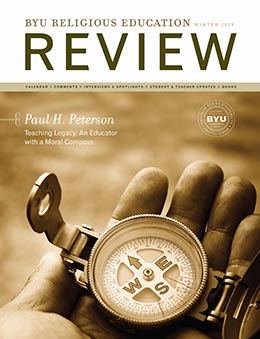Team Compiles Stories of Saints in World War II Europe
Research Update
Roger P. Minter and team
 The Presidency of the East German Mission met with the district presidents in 1941. They are shown here with three full-time missionaries. By 1945 the mission president and three district presidents had been killed.
The Presidency of the East German Mission met with the district presidents in 1941. They are shown here with three full-time missionaries. By 1945 the mission president and three district presidents had been killed.
 Young men and women of the Tilsit Branch clown around after Sunday School on a wintry 1941 Sunday. Several of these young men died as soldiers on the Russian Front. Courtesy of Helga Meyer.
Young men and women of the Tilsit Branch clown around after Sunday School on a wintry 1941 Sunday. Several of these young men died as soldiers on the Russian Front. Courtesy of Helga Meyer.
In the summer of 1939, the East German Mission, based in Berlin, and the West German Mission, based in Frankfurt, were two of the largest missions in the Church. With thirteen districts apiece, they included 113 branches with 7,608 and 5,428 members respectively. During the last week of August, both mission presidents–Thomas E. McKay and M. Douglas Wood–were instructed to have all missionaries from the United States leave Germany. The evacuation was successful, and by the end of the week, Latter-day Saints in Germany were under the leadership of several German priesthood holders. On Friday, September 1, 1939, World War II began with the German invasion of Poland.
During the ensuing five and one-half years, the German members of the Church were caught in the middle of the worst conflict in history. Unable to emigrate, they suffered with the rest of Germany when what had appeared to be a victorious enterprise evolved into destruction.
Roger P. Minert, associate professor of family history in the Department of Church History and Doctrine at Brigham Young University, has been researching the fate of German Latter-day Saints in World War II for decades.
He is currently preparing to publish several books featuring first-person testimony of the war.
Tens of millions of soldiers and civilians in Europe perished before Germany lay in ruins in May 1945. Latter-day Saints served in the German army, navy, and air force; worked as nurses and air raid wardens; and worked in government offices. Many adolescent members of the branches were inducted into the Hitler Youth organizations, and hundreds more spent a year in the government labor force. German priesthood holders died in combat in France, Russia, and North Africa, while family members back in Germany and Austria lost their homes to invading armies and were killed in air raids.
Church historians and archivists note that no book about German Latter-day Saints during World War II has been published, and it is high time that one be written. Dr. Minert began his concentrated effort to this end in October 2005 by assembling a team of researchers. Since that time, the team has identified more than 475 surviving eyewitnesses and has interviewed half of them. Dr. Minert’s team has collected hundreds of photographs, documents, biographies, and autobiographies and has sent hundreds of letters and e-mails across the globe in search of more stories.
Dr. Minert’s team features long-time family history researcher and German native Marion Wolfert of Stadthagen, Germany (now of Salt Lake City). Student research assistants include one people finder, two interview text editors, one cartographer/
German and Austrian Latter-day Saints were involved in essentially every major European action in World War II. They served among the invasion forces moving into Poland in 1939, into France in 1940, and into Russia in 1941. They served on the sands of North Africa, on the coast of Normandy, in the air over England, and on the seas. They parachuted onto Malta, perished in the hell that was Stalingrad, and aided in the hopeless attempt to defend Berlin. While deacons, teachers, priests, and elders were killed in battle and disappeared in action in foreign countries, their wives, sisters, and mothers back home exerted their best efforts to keep Church meeting schedules and programs intact. Most were successful in holding worship services all through the war, but they often did so in private homes after the meeting rooms were destroyed in air raids and by the artillery of invading armies.
Women, children, and the elderly often lost their homes in the major cities and were forced to seek refuge at relatives’ rural homes and farms. By the end of the war, nearly one half of the branches in the East German Mission had dissolved because their members were killed or evacuated. Members of the Church suffered violence at the hands of invading soldiers, died in flight from Axis territory, and died of starvation and disease because sanitation was poor and qualified medical personnel was absent.
No official listing of Latter-day Saint losses in Germany and Austria has ever been compiled, but Dr. Minert’s team has made great progress toward this end. Two student researchers are compiling what is called the Gedenkbuch–a collection of the vital details of all known members of the Church who did not survive World War II. The first German member of the Church to perish in WWII was Willy Klappert, a deacon from the Frankfurt Branch, who died on the second day of the Polish campaign, September 2, 1939. The last would have been one of the many who languished as prisoners of war in Russia until 1949. The fate of more than one hundred soldiers and other members remains a mystery.
Dr. Minert's team invites the submission of names of eyewitnesses (persons who were members of the Church in Germany and Austria before 1945), as well as documents and stories left by eyewitnesses now deceased. Information may be submitted to him at 801-422-2370 or by e-mail at rpm@byu.edu. The project's Web site is www.germanldsinwwii.org.
